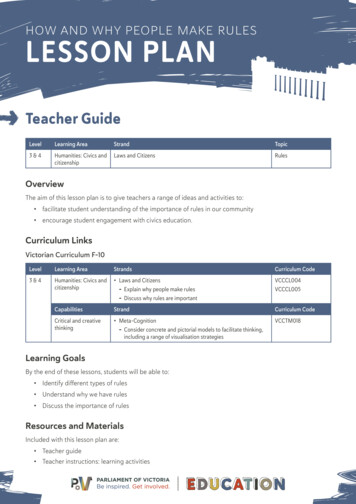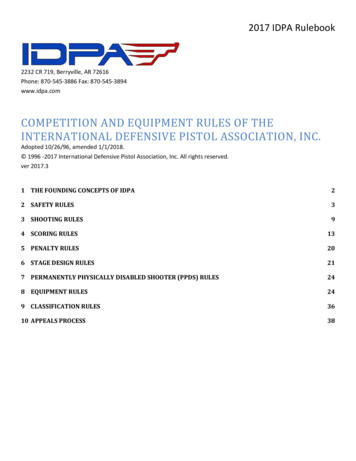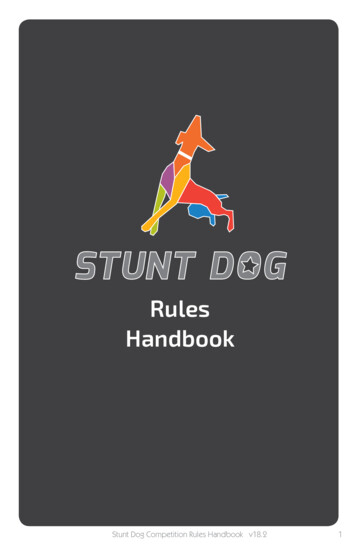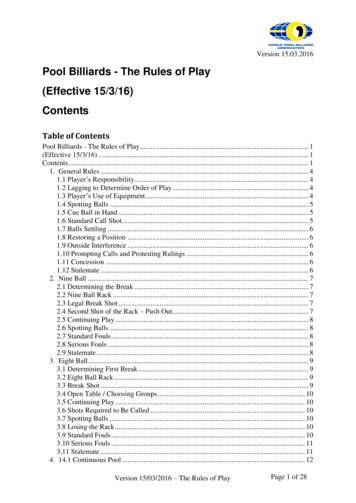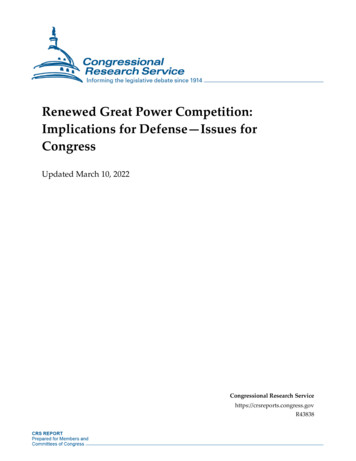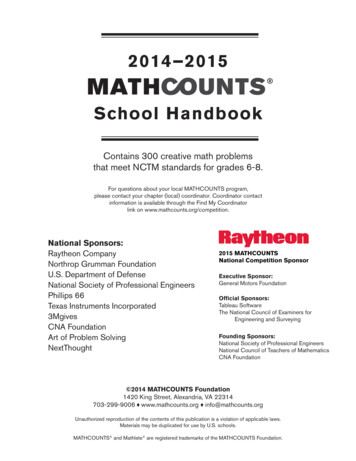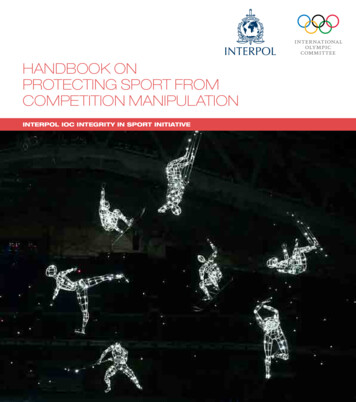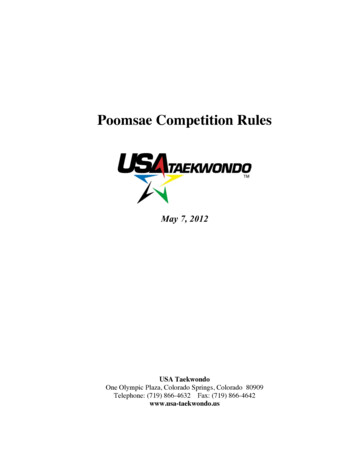
Transcription
Poomsae Competition RulesMay 7, 2012USA TaekwondoOne Olympic Plaza, Colorado Springs, Colorado 80909Telephone: (719) 866-4632 Fax: (719) 866-4642www.usa-taekwondo.us
.
Poomsae Competition RulesTABLE OF CONTENTS1.Poomsae Competition Rules .2.Appendix I: Competition Coordinator’s Commands . 273.Appendix II: Competition Coordinator’s and Referee’s Hand Signals. 294.Appendix III: Scoresheets . 315.Appendix IV: Poomsae Resources . 356.Appendix V: Sample Double Elimination Brackets. 391
Article 1.PurposeThe purpose of the Poomsae Competition Rules is to smoothly and fairly manage all matterspertaining to Poomsae competitions promoted, organized or sanctioned by USA Taekwondo(USAT), and to ensure the standardization of Taekwondo Poomsae competition in the United Statesin accordance with the World Taekwondo Federation (WTF)—the international federation governingthe sport of Taekwondo.A competition that does not follow the fundamental principles of these rules cannot be recognizedas USA Taekwondo Poomsae competition.These competition rules shall apply to all Poomsae competitions to be promoted and/or organizedor sanctioned by the USAT. If any USAT association or event promoter wishes to modify any partof the Competition Rules for a particular competition, they must first receive written approval fromthe USAT.Any organization wanting to make a change to some portion of the existing rules must submit theproposed changes to the USAT, along with the reasons for the change in writing. Approval for anychanges in these rules must be received from the USAT one month prior to the scheduledcompetition.Changes such as increase or decrease in the number of USAT Poomsae Referees and Judges in eachring or their seating arrangement, the number of rounds, the number of Poomsae performed in eachround, change in the size of the Competition Area, change in the waiting time between the 1st and2nd Compulsory Poomsae, change in the position of the inspector, recorder and/or commissiondoctor, etc., may be made after first gaining the written approval of the USAT. However, suchessential matters as scoring must not be changed under any circumstances.Article 3.Competition AreaThe Contest Area shall measure at least 10m x 10m (30 ft x 30 ft) and have a flat surface withoutany obstructing projections. Only USAT-approved mats shall be used at USAT-sanctionedPoomsae Championships, and must provide safe and secure footing for the competitors.1. Demarcation of the Contest Area1)The 10m x 10m area shall be called the Contest Area.USAT Poomsae Competition RulesPage 1
2. Indication of Positions (see Figure 1)1) Referee: The Referee shall be positioned beside Judge No. 1.2) Judges: The judges are positioned along Boundary Lines 1 and 3. They are 1m from theboundary line with 1m separation between adjacent judges.3) Contestants: Contestants’ starting position shall be 2m back from the center of the ContestArea, toward boundary line #3.4) Recorder’s desk: It shall be positioned at 3m from the Referee on the right side.5) Competition coordinator(s): Competition coordinator(s) shall be positioned outside theContest Area, 1m away from the corner between boundary lines #1 and #2.6) Standby contestants and coaches: Standby contestants and coaches shall be positionedoutside the Contest Area; if possible, 3m away from the corner between boundary lines #3and #4.7) Inspection desk: An Inspection Desk shall be positioned at the entrance of the Contest Areaoutside the corner of boundary lines #3 and #4.3. Judging Formats1) Seven Judge Format: The seven judges (including the Referee) shall sit 1m away from theCompetition Area with 1m separation between adjacent judges. Four judges (including theReferee) shall face the front of the contestants and three shall face the back. The boundaryline adjacent to the four front judges shall be deemed boundary line #1, followed by,clockwise, boundary lines #2, #3, and #4. Judges are positioned and numbered clockwisefrom the left facing boundary line #1.2) Five Judge Format: In the case of a five judge format, three judges (including the Referee)shall be positioned facing the contestants and the two judges facing the back of thecontestants, in the same order as the seven judge format.3) Three Judge Format: In the case of a three judge format, two judges (including theReferee) shall be positioned facing the contestants and one judge facing the back of thecontestants, in the same order as the seven judge format.Judge Format Notes:The position of the Referee and Judges in the Seven, Five and Three Judge systems may bemodified to all judges facing the contestants or other appropriate arrangement to accommodatescoring systems, venue or other limitations and constraints that may impact the competition.Page 2USAT Poomsae Competition Rules
Judging System Notes:USAT Team Trials, National Championships (for WTF divisions) and qualifying tournamentsshould use the seven judge format.At USAT qualifying tournaments and for non-WTF divisions (color belts and black belts under14 years old) in other USAT sanctioned events, the five judge format may be used with theapproval of USAT if the number of USAT Certified Poomsae Referees is insufficient toimplement the seven judge format.At USAT sanctioned events that are not qualifying tournaments, the three judge format may beused for non-WTF divisions (color belts and black belts under 14 years old) with the approvalof USAT, if the number of WTF International Poomsae Referees and USAT Certified PoomsaeReferees is insufficient.— NOTES —USAT Poomsae Competition RulesPage 3
Figure 1. Field of PlayRec:R:J1, 2, 3, 4, 5, 6C1:C2:C3:C4:1, 2, 3, 4RecorderRefereeJudgeCompetition AreaContestantsStandby Area for Contestants and CoachCompetition CoordinatorBoundary LinesPage 4USAT Poomsae Competition Rules
Article 4.Contestants1. Qualifications of USAT Poomsae Contestants1) Residency and citizenship: Residency and citizenship requirements vary among events.USAT national championships and team trials require contestants to be citizens of theUnited States.2) Registered USAT athlete member3) Black Belts: All black belt contestants must submit a copy of their Dan/Poom Certificate,current USAT identification card, and birth certificate at the time of registration with theTournament Organizing Committee.4) Color belts: Contestant must be a color belt, with a USAT recognized rank (1st & 2nd GeupRed Belt, 3rd & 4th Geup Blue Belt, 5th & 6th Geup Green Belts, 7th & 8th Geup YellowBelts). Color belt contestants may only wear a yellow, green, blue or red belt, according tothe contestant’s Geup rank.5) All contestants participating in a tournament are required to observe the USAT Code ofConduct and the rules of the tournament. Violators are subject to sanction by the USAT.2. Uniform for Contestants1) Official Uniform for ContestantsAll contestants must wear a white Taekwondo V-neck USAT approved uniform (dobok) ingood condition. Black Belts must wear black-collared uniforms. Color belts cannot wearblack-collared uniforms.Patches, embroidery, logos, team names, country names, athlete names, and stripes arepermitted on the uniform. Logos or names on the back of the uniform and patches on thechest area of the uniform are also allowed.Shoes may not be worn. No jewelry or ornaments may be worn. No hats or items may beworn on the head except for religious coverings or soft ties to contain the hair.NO TAPE WILL BE ALLOWED ON ANY PART OF THE UNIFORM.3. Personal Hygiene1) All competitors must maintain the highest standard of personal hygiene, keep their nails cutshort, and groom their hair neatly.2) Any violators of Section 1, 2, and 3 will be required to correct the violation within oneminute, or shall be subject to disqualification.4. Medical Control1) At Taekwondo events promoted or sanctioned by the USAT, any use or administration ofdrugs or chemical substances described in the USOC anti-doping by-laws is prohibited.USAT Poomsae Competition RulesPage 5
2) The USAT may carry out any medical testing deemed necessary to ascertain if a contestanthas committed a breach of this rule. Any winner who refuses to undergo this testing or whoproves to have committed such a breach shall be removed from the final standings, and therecord shall be transferred to the contestant next in line in the competition standings.The organizing committee shall be responsible for making arrangements to carry outmedical testing.Article 5.Classification of CompetitionContestants may compete in more than one competition division unless they are limited by genderor age.1. Recognized Poomsae Competition1)2)3)4)5)Men’s IndividualWomen’s IndividualMen’s TeamWomen’s TeamPair (one male, one female)2. Freestyle Poomsae Competition1)2)3)4)Men’s IndividualWomen’s IndividualPair (one male, one female)Mixed Team (composed of 5 members including at least 2 males and 2 females)Page 6USAT Poomsae Competition Rules
Article 6.Divisions by Gender and Age1. Recognized Poomsae Competition1) Men, women and mixed divisions shall be divided according to age.2) There is no specific limitation to Poom/Dan rank for team competition.3) Male and female divisions shall be classified as follows:Division7 andUnderAge (Years)6-79 andUnder11 andUnder13 andUnder17 andUnder29 andUnder39 andUnder49 andUnder59 59Over5960 Male111111111Female111111111IndividualDivision9 and Under13 and Under29 and UnderOver 29Age6-9 years old10-13 years old14-29 years old30 years or olderPair2222Male3333Female3333TeamNotes:Shaded cells are official WTF divisions competed at USAT sanctioned events.Unshaded cells are USAT divisions competed in USAT sanctioned events.The age limit for each division is based on the year—not on the date—when the Championships areheld. For example, in the Under17 division, contestants shall be between 14 and 17 years old. Forexample, if the Junior Poomsae Championships are held on 29 July 2011, contestants born between1 January 1994 and 31 December 1997 are eligible to participate.2. Freestyle Poomsae Competition1) Contestants shall be over 14 years old during the year of the competition.USAT Poomsae Competition RulesPage 7
Article 7.Methods of Competition1. The methods of competition are:1) Single elimination tournament formatIn the single elimination tournament a competitor is eliminated from competition after oneloss.- Competitors are matched with opponents randomly or by seeding.- The order of competition is randomly assigned.- Each pair of competitors (Chung and Hong) enters the Competition Area together, butperform individually, with Chung (blue) performing first, followed by Hong (red), eachcompetitor standing on their assigned positions when not performing.- The Referee declares the winner based on the score and both competitors leave theCompetition Area together.- Competitors perform one or two forms in each round selected by the USAT PoomsaeReferee Team from the Compulsory Poomsae.2) Round robin tournament formatIn the round robin tournament each competitor competes with every other competitor.- Competitors are matched with opponents randomly; the order of competition is randomlyassigned.- Each pair of competitors (Chung and Hong) enters the Competition Area together butperform individually, with Chung performing first, followed by Hong.- The Referee declares the winner based on the score and both competitors leave theCompetition Area together.- Competitors perform one or two forms in each round randomly*selected by the USATPoomsae Referee Team from the Compulsory Poomsae.3) Cut-off tournament formatThe cut-off tournament is a competition format that has a maximum of three rounds, apreliminary, semi-final and final round. If the division has 20 or more competitors thecompetition shall start from the preliminary round.- The division may be split into groups, with each group judged by different judges in thepreliminary round.- The order of the competitors in the preliminary round and in each subsequent round israndomly determined.- In the preliminary round, each contestant performs one or two assigned forms randomlyselected from the Compulsory Poomsae by the Referee Chair. All competitors perform thesame form(s). Scores are totaled for each contestant. Those with scores in the top 50%Page 8USAT Poomsae Competition Rules
advance to the semi-final round.- If the number of contestants in the division or groups is odd, then the number ofcontestants advancing to the next round will be rounded up. For example if there are 23contestants in the group, then the 23 contestant number is rounded up to 24, and the 12contestants with the highest scores shall advance to semi-final round. If there are 9 to 19contestants, the competition shall start from the semi-final round.- In the semi-final round, each contestant will perform two forms (one form may beperformed) randomly selected from the Compulsory Poomsae (with the form(s) from thepreliminary round excluded), and the 8 contestants with the highest scores advance to thefinal round.- When 8 or fewer contestants are participating, the competition shall start from the finalround.- In the final round the contestants perform the two randomly selected forms from theCompulsory Poomsae that were not performed in the previous round. In the case wherethere are 8 or fewer contestants the final round is also the first round, and two CompulsoryPoomsae randomly selected forms shall be performed.- The top four contestants / pairs / teams shall be awarded prizes based on their points.- 3rd and 4th places are awarded bronze medals.Method of Competition Notes:The number of Poomsae performed in the preliminary and semi-final rounds may be modified afterfirst gaining the written approval of the USAT.The WTF World Championships and the USAT National Championships use the Cut-Offtournament competition method. For other competitions, other methods of competition may beused.Modified Single Elimination Format for Color Belt DivisionsFor Grassroots and recreational divisions at USAT State Championships, Regional Qualifiers,Nationals and Junior Olympic Championships, cut-off format, modified cut-off format, a modifiedbracketed competition format (single or double elimination) or other format may be used, at thediscretion of tournament organizers. (See below.)Modified single elimination format (Grassroots and recreational divisions)In the single elimination format a competitor is eliminated from competition after one loss.- The competition, in principle, will be judged by one referee and four judges; if there arenot enough referees, the contest can be conducted by one referee and two judges.- Competitors are randomly matched with opponents.- Each pair of competitors (Chung and Hong) enters the Competition Area together, andperforms at the same time.- WTF/USAT scoring criteria apply, but scoresheets or electronic scoring may not be used.USAT Poomsae Competition RulesPage 9
- Judges declare the winner by extending the arm in the direction of Chung or Hong uponthe Referee’s command, “Pyo-chul” (score). When the winner is recorded, the referee hasthe players bow, and dismisses them.- The competition is continued until first place, second place and third place winners aredetermined; note that in this format, there are two third place awards.Modified double elimination format (Grassroots and recreational divisions)In the double elimination format a competitor is eliminated from competition after twolosses.- The competition, in principle, will be judged by one referee and four judges; if there arenot enough referees, the contest can be conducted by one referee and two judges.- Competitors are randomly matched with opponents.- Each pair of competitors (Chung and Hong) enters the Competition Area together, andperforms at the same time.- WTF/USAT scoring crieria apply, but scoresheets or electronic scoring are not used.- Judges declare the winner by extending the arm in the direction of Chung or Hong uponthe Referee’s command, “Pyo-chul” (score). When the winner is recorded, the referee hasthe players bow, and dismisses them.- The competition is continued until first place, second place and third place winners aredetermined; note that in this format, there is only one third place award.NOTE: See Appendix for sample brackets for the double elimination format.Double elimination brackets for any number of competitors can be generated //www.bracketmaker.com/tlist.cfm?tid 215662http://www.printyourbrackets.com/Note: Random sequences for any number of competitors, or random poomsae, can begenerated here:http://www.random.org/Page 10USAT Poomsae Competition Rules
Article 8.Recognized Poomsae1. Black BeltsDivisionCompulsory Poomsae7 and Under9 and UnderTaegeuk 2, 3, 4, 5, 6, 7, 8 Jang, Koryo11 and Under13 and UnderTaegeuk 3, 4, 5, 6, 7, 8 Jang, Koryo, Keumgang17 and UnderTaegeuk 4, 5, 6, 7, 8 Jang, Koryo, Keumgang, Taeback29 and UnderTaegeuk 6, 7, 8 Jang Koryo, Keumgang, Taeback, Pyongwon, Shipjin39 and Under49 and Under59 and UnderOver 59PairKoryo, Keumgang, Taeback, Pyongwon, Shipjin, Jitae,Chonkwon, Hansu9 and UnderTaegeuk 2, 3, 4, 5, 6, 7, 8 Jang, Koryo13 and UnderTaegeuk 3, 4, 5, 6, 7, 8 Jang, Koryo, Keumgang29 and UnderTaegeuk 6, 7, 8 Jang, Koryo, Keumgang, Teaback, Pyongwon, Shipjin9 and UnderTaegeuk 8 Jang, Koryo, Keumgang, Taeback,Pyongwon, Shipjin,Jitae, ChonkwonTaegeuk 2, 3, 4, 5, 6 , 7, 8 Jang, Koryo13 and UnderTaegeuk 3, 4, 5, 6, 7, 8 Jang, Koryo, Keumgang29 and UnderTaegeuk 6, 7, 8 Jang, Koryo, Keumgang, Taeback, Pyongwon, ShipjinOver 29Taegeuk 8 Jang, Koryo, Keumgang, Taeback,Pyongwon, Shipjin, Jitae, ChonkwonOver 29TeamTaegeuk 8 Jang, Koryo, Keumgang, Taeback, Pyongwon, Shipjin,Jitae, ChonkwonUSAT Poomsae Competition RulesPage 11
2.Color BeltsDivisionCompulsory PoomsaeYellow (7th & 8th Geup)All agesTaegeuk 1, 2 JangGreen (5th & 6th Geup)All agesTaegeuk 1, 2, 3, 4 JangBlue (3rd & 4th Geup)All agesTaegeuk 1, 2, 3, 5, 6 JangRed (1st & 2nd Geup)All agesTaegeuk 1, 2, 3, 4, 5, 6, 7, 8 JangArticle 9.Freestyle Poomsae1. Freestyle performance is based on Taekwondo techniques, with the addition of music andchoreography.Composition of freestyle Poomsae:1) “Yeon-mu” line (i.e., the progress line of the Poomsae) shall be the choice of the contestant.2) Number of Poom: Each performance shall be composed of 20 to 24 poom (each poom shallbe no more than 5 movements).3) Technique: Each performance shall be composed of attacking and defending techniques ofTaekwondo with 60% foot techniques and 40% hand techniques.4) Music and choreography shall be the choice of the contestant.5) The performed techniques must be within the boundaries of Taekwondo. The USATPoomsae Referee Team will determine the validity of the performed Taekwondo techniqueswhen the contestant submits a Free Style Poomsae Performance Plan.Page 12USAT Poomsae Competition Rules
Article 10.Duration of ContestDuration of Contest by Division1. Recognized Poomsae: Individual, Pair and Team competitions from 30 to 90 seconds.2. Free Style Poomsae: Individual, Pair and Mixed Team competitions from 30 to 70 seconds.3. The waiting time between 1st and 2nd Poomsae is 30 to 60 seconds.Article 11.Order of CompetitionThe order of competition shall be random and will be accomplished by drawing of lots or by otherrandom process.Article 12.Prohibited Acts / Penalties1. The Referee shall declare penalties for any prohibited acts.2. Penalties are defined as “Gam-jeom” (deduction of points by penalties).3. “Gam-jeom” shall be declared on the following prohibited acts:1) Uttering undesirable remarks or any misconduct on the part of a contestant or a coach.2) Any act that intentionally interferes with another competitor, coach or official.4. Should a contestant be assessed two (2) deductions, the referee shall declare the contestant aloser on penalties. “Gam-jeom,” as defined in this Article, refers to deduction of points due tobehavior that disrespects the spirit of sport, rather than due to judges’ scoring in terms ofaccuracy and presentation.Article 13.Procedures of the Contest1. Call for contestants. Thirty minutes prior to the scheduled start of the contest, the names of thecontestants shall be announced three times in the contestants’ training area. Any contestant whofails to appear in the Competition Area after the “Chool-jeon” command of the competitioncoordinator shall be regarded as having withdrawn from and forfeited the match.2. Standby. Each contestant, accompanied by only one coach, shall wait at the contestants’waiting area for the physical and uniform inspection.3. Physical inspection and uniform inspection. After being called, the contestants shall undergoUSAT Poomsae Competition RulesPage 13
a physical inspection and a uniform inspection at the specified inspection desk by an inspectordesignated by the USAT. The contestant shall not show any signs of aversion, and shall not bearany object that may cause harm to the other contestant.4. Entering the Competition Area. Following the inspection, the contestant(s) shall enter thecontestant standby waiting area with one coach. Upon the Competition Coordinator’s command(see Appendix I) of “Chool jeon” (enter) the contestant(s) shall enter the Contest Area. Whenissuing the command “Chool jeon” the Competition Coordinator motions with his/her righthand directing the contestant(s) into the Contest Area to the contestant’s designated spot (seeAppendix II). The coach remains in the designated contestant standby area.1) Elimination and Round Robin Tournaments- In individual competitions, the competitors, designated as Chung and Hong enter together.- Contestants shall face each other and make a standing bow at the competitioncoordinator’s command of “Cha-ryeot” (attention) and “Kyeong-rye” (bow).- After “Kyeong-rye,” Chung performs first and then Hong. In pair and team competitions,the Chung team/pair and the Hong team/pair enter together. After “Kyeong-rye,” the Hongteam/pair exits and the Chung team/pair performs first, then Hong team (pair) performs.- When issuing the command “Kyeong-rye” the Coordinator motions with his/her handsdirecting the contestant(s) bow to each other or to bow to the judges along Boundary Line#1.2) Cut-off Tournament- Individual, pair and team competitors enter the Competition Area alone.5. Beginning of the Performance. The performance begins when the Competition Coordinatorannounces “Cha-ryeot,” “Kyeong-rye,” “Joon-bi” and “Shi-jak” (start).6. When two Poomsae are performed. At the end of the first Poomsae the competitioncoordinator announces “Bah-roh” then “Shi-ah” at which point the contestant may return tothe contestant waiting area to consult with the coach during the waiting time between the 1stand 2nd Poomsae. At the end of the waiting time the contestant returns to the designated spot inthe Competition Area or the Competition Coordinator will command “Chool jeon” and motionwith his/her hand directing the contestant(s) into the Competition Area to the designated spot.7. Beginning of the performance of the 2nd Poomsae. The performance begins when theCompetition Coordinator announces “Cha-ryeot,” “Joon-bi” and “Shi-jak” (start). There is nobow before the 2nd Poomsae.8. Completion of performance. The performance ends with the Competition Coordinatorcommanding “Bah-roh” (back to ready) “Cha-ryeot,” “Kyeong-rye.” When issuing thecommand “Kyeong-rye” the Competition Coordinator motions with his/her hands directing thecontestant(s) bow to each other or to bow to the judges along Boundary Line #1.Page 14USAT Poomsae Competition Rules
9. Retirement of the contestants. After the standing salute the contestant exits on theCompetition Coordinator's command “Tuae-jahng” (exit). When issuing the command“Tuae-jahng” the Coordinator motions with his/her hand directing the contestant(s) from thedesignated spot out of the Competition Area. The hand motion shall be respectful, performedwith formality, not in a dismissive fashion.10. When using an electronic scoring device. The judges enter the score into the electronicscoring device after confirming the total score. The total score entered by the judges appear onthe public display board. The referee shall declare the winner according to the results of thejudges.11. When using the scoring ballot. The judges score accuracy in real time, and complete thescoring ballot after confirming the total score. After the judges’ ballots are recorded, therecorder announces the final result. The referee shall declare the winner according to the resultsof the judges.Article 14.Competition Coordinator1. Qualifications1) The Referee Chair shall assign the Competition Coordinators.2. Duties1) One or two Competition Coordinators shall be assigned.2) The Competition Coordinator(s) shall verify the contestants’ identities and direct contestantsin and out of the venue, and shall assist the refereeing officials to ensure the unimpededprogress of the competition and declare the winners/medalists.Article 15.Scoring CriteriaScoring shall be made in accordance with the USAT and WTF Competition Rules (see score sheets,Appendix III.)1. Recognized Poomsae1) Accuracy (4 points)a. Accuracy of basic movementsb. Balancec. Accuracy of details of each Poomsae2) Presentation (6 points)a. Speed and power.b. Strength/speed/rhythmc. Expression of energyUSAT Poomsae Competition RulesPage 15
3) Allotted ScoringScoring CriteriaAccuracy (4.0)Presentation (6.0)Details of Scoring CriteriaAccuracy of details of each Poomsae.Accuracy of basic movements and balancePoints4.0Speed and power2.0Strength/speed/rhythm2.0Expression of energy2.02. Freestyle Poomsae1) Technical skills (6 points)a. Level of difficulty of foot techniquesb. Accuracy of movementsc. Degree of completion of Poomsae2) Presentation (4 points)a. Creativityb. Harmonyc. Expression of energyd. Music and choreography3) The USAT Poomsae Referee Team will establish the level of difficulty for kickingtechniques each year.Page 16USAT Poomsae Competition Rules
4) Allotted ScoringScoring CriteriaDetails of Scoring CriteriaLevel of difficultyof foot techniques(3.0)Technical skills (6.0)Accuracy ofmovement (1.5)Degree ofcompletion ofPoomsae (1.5)Height of jumpNumber of jumpingkicksGradient of turnNumber ofconsecutive kicksAcrobatic actionsBasic movementsDesignated technicalmovementPracticabilityConnectivity betweenoffensive anddefensive movementsPoints3.01.51.5CreativityPresentation (4.0)HarmonyExpression of energy4.0Music and choreographyMaximum PointsArticle 16.10.0Methods of Scoring1. Recognized Poomsae1) Total score is 10 points2) Accuracya. Basic score is 4.0b. 0.1 point shall be deducted each time a contestant makes small errors; does not performthe basic movements accurately.Deduction of 0.1 point per small mistake in accurate performance0.1 point shall be deducted each time a stance (Apgubi, Dwitgubi, Beomseogi and allthe other standing movements and positions), hand or foot technique (Makki, Jireugi,Chigi and all the other hand and foot movements) is not performed as explained in thecurrent Kukkiwonn Taekwondo Textbook. (See Appendix IV.)USAT Poomsae Competition RulesPage 17
c. 0.3 point will be deducted each time a contestant makes a serious mistake.Serious mistake in accuracy0.3 points shall be deducted when incorrect actions or techniques are performed orcorrect techniques or actions are omitted; i.e., serious deviations from the Poomsae asdescribed in the Taekwondo Textbook.Examples:- Eolgul Makki is performed instead of Arae Makki.- Dwitgubi is performed instead of Juchum Seogi- Kihap (yell) or stomp is not made or made in the wrong place- Brief stops during movements (forgetting the next movement for three seconds orlonger)- Looking in the wrong direction (eyes should be focused in the direction of movementbut should not anticipate the next direction of movement)- When the raised foot steps down early or in the wrong spot (not just a brief balancingtouch)- Not finishing the Poomsae within one foot length of the original starting point3) PresentationA. Basic total score (6.0 points)Deduction of points in presentation shall be made for the overall performance of thePoomsae, not for every small or serious mistake during the performance:- 2.0 points for speed and power- 2.0 points for control of power, speed and rhythm- 2.0 points for expression of energya. Speed and Power (2.0 points)Ability to perform Poomsae shall be evaluated on whether the movements areperformed in accordance with the characteristics of the pertinent movement; forexample, attacking techniques such as Jireugi or Chagi, are best performed with asoft start, accelerating with a balance between speed and power, using the bodyweight to achieve a maximum effect; or, special movements are performed slowly,and intentionally, with power and balance.Examples:- Deduction shall be made if too much strength is revealed in the beginning of themovements, as this slows down the movement and reduces the power andeffectiveness of the movement.- Deduction shall be made if the contestant exaggerates a movement beyond theculmination of that movement to show power in the next movement, orexaggerates the reaction of the body to express power.Page 18USAT Poomsae Competition Rules
b. Control of Power, Speed and Rhythm (2.0 points)- Control of power means the greatest power is shown at the most critical moment ofthe movement, usually the culmination, through speed and softness.- Control of speed means an appropriate connection between actions and changes inspeed, s
Poomsae Competition Rules May 7, 2012 USA Taekwondo One Olympic Plaza, Colorado Springs, Col


